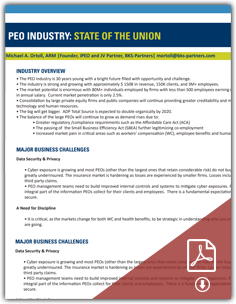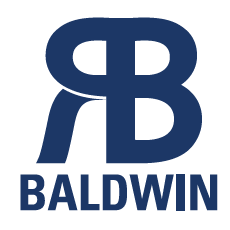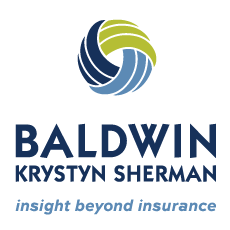PEO Industry: State of the Union
Michael A. Ortoll, ARM |Founder, iPEO and JV Partner, BKS-Partners| mortoll@bks-partners.com
INDUSTRY OVERVIEW
- The industry is strong and growing with approximately $ 150B in revenue, 150K clients, and 3M+ employees.
- The market potential is enormous with 80M+ individuals employed by firms with less than 500 employees earning on average $ 25K in annual salary. Current market penetration is only 2.5%.
- Consolidation by large private equity firms and public companies will continue providing greater creditability and more capital for technology and Human Resources.
- The big will get bigger. ADP Total Source is expected to double organically by 2020.
- The balance of the large PEOs will continue to grow as demand rises due to:
- Greater regulatory /Compliance requirements such as the Affordable Care Act (ACA)
- The passing of the Small Business Efficiency Act (SBEA) further legitimizing co-employment
- Increased market pain in critical areas such as workers’ compensation (WC), Employee Benefits and Human Resources
 The PEO industry is 30 years young with a bright future filled with opportunity and challenge.
The PEO industry is 30 years young with a bright future filled with opportunity and challenge.
MAJOR BUSINESS CHALLENGES
Data Security & Privacy
- Cyber exposure is growing and most PEOs (other than the largest ones that retain considerable risk) do not buy coverage or are greatly underinsured. The Insurance market is hardening as losses are experienced by smaller firms. Losses include both first and third party claims.
- PEO management teams need to build improved internal controls and systems to mitigate cyber exposures. Private data is an integral part of the information PEOs collect for their clients and employees. There is a fundamental expectation that this data is secure.
A Need for Discipline
- It is critical, as the markets change for both WC and health benefits, to be strategic in understanding who you are and where you are going.
- As pain increases in many areas for small-to- mid-sized businesses, there is a need for greater discipline in qualifying.
- Be proactive. Determine what you want to deliver and consider greater focus on your organization’s values and margins.
WORKERS COMP OUTLOOK
Capacity Challenges Loom
Amtrust recently became the third largest Workers’ Compensation (WC) insurer in the US. It is the only large first dollar underwriter, with the exceptions of ProSight and several regionals. Zurich, AIG and Chubb (ACE) are focusing on larger, healthy PEOs that can take large retentions.
So what is missing, and what is needed?
- Greater capacity from new players
- Rating plan alternatives, such as retro plans with low maximums or small deductibles
- Larger deductibles
- Win/win rather than win/lose propositions such as first dollar deals
Need for improved selection/underwriting-pricing
- Many PEOs price WC too thin not understanding loss development.
- Buying guaranteed cost (GC) makes it easier to be shortsighted.
- Find your sweet spot and stay there no matter how easy it is to write new business. It isn’t always profitable.
- Incentivize your producers to go after profitable business and adjust the pricing strategy based upon the client’s results.
Distribution
- Pick your partners wisely both for your internal sales force and your external agents/brokers and other centers of influence.
- Target those in your niches where you have expertise and demonstrated results.
- Qualify all deals. Fight the temptation to going outside your comfort zone.
- Make exceptions to the rule instead of carving out everything which may not fit the master.
- Partner with existing influential distribution networks i.e. private equity firms, Insurance agents, CPAs, PEO brokers, attorneys, and bankers
Key States and Challenges/Opportunities Ahead
- Florida -pricing for clients and PEOs will begin to increase (15-25 % including consent to rate) due to removal of attorney caps on existing claims.
- Texas and New York -due to continued rate inadequacy, capacity will shrink. The state funds are the most competitive markets.
- California – conditions worsening (due to overall claims environment- greater frequency and severity, resulting in development of 300% at 12 months) and likely to continue deteriorating.
- Oklahoma -is next problem state as filed rates are much lower than advisory rates due to expected market changes/reform, similar to opt out in Texas.
The Staffing Industry – A Potential Black Eye
- Many insurers link both industries erroneously.
- Issues include: fast growth, piggy backing, credit risk, misclassification of codes, lack of safety training, tough to manage employees, poor risk selection, etc.
- Best in class should be pursued but not be written in PEO books as it is sole employment not co- employment.
Risk management BASIC resources required to succeed
- Safety training and loss control
- Claims consulting
- Analytics and loss forecasting to dictate service allocation by client and status (good, rehab or bad – carve out or terminate)
NAPEO Risk Management certification
- Important program to help with WC improvement and operational needs.
Workers Compensation RESULTS
- WC combined ratio (CR) between 14’-15’ went down from 100% to 94% (one of lowest in the last 25 years). While that is good news, the concern is the industry wants to underwrite to mid-90s CR due to a lack of investment income.
- Claims frequency is down 3% and over last 20 years down more than 50%. However, claims severity is increasing.
- The estimated WC residual market pool CR is 106 % thus under control, also historically low and reserve deficiency is down from $ 10B to $ 7B.
- In addition to passing opt out language in Feb 2014, similar legislation was tested in South Carolina and Tennessee (yet didn’t advance in 2015) allowing employers that qualify to utilize an alternative to traditional WC. This will continue as will tort reform battles in states such as Florida with the plaintiff’s bar.
- Legislation of marijuana in 24 states & DC has caused a stir, especially as more states look at approving it for recreational & medicinal use, yet employers reserve the right to test & terminate for use which will be battled as it stays in the body for a long period of time.
- Prescription drugs represent 17% of every WC dollar spent and the fastest growing expense line item (has grown 10% in the last two years). In order to control it, we need to address following factors:
- Concern with physician dispensing
- Narcotic addiction rate is high
- The use of compounding medicines is increasing
HEALTHCARE OUTLOOK
Some historical perspective: Over the last decade 2005-2015, per a Kaiser Study, the family coverage premium has increased 61% and workers have contributed 83% of increase.
What can PEOs do to control and provide long term value in this area?
- Our industry is partly at fault by allowing for adverse selection through low pricing, participation and contribution levels. The major players including Aetna, CIGNA, United, BCBS, Humana, and Kaiser, have experienced growing pains with PEOs. Some have dropped out of this industry similar to what we have seen in the WC industry.
- Expect state Insurance exchanges to grow despite some carriers exiting.
- The master versus non master health plan approach amongst PEOs should match their growth strategy by region and class of business.
- Health plans should protect WC master to mitigate WC fraud not increase it. This is a big challenge. More importantly, master group health plans should be aligned to deliver the business PEO strategically desires.
- According to a recent NSBA survey, PEOs have an opportunity to provide solutions due to employers’ negative reactions to ACA Compliance requirements. Noted in the survey:
- Employers reducing hours for existing employees – 10% of participants
- Hiring more part-time than full time -15%
- Sub-contracting / using staffing companies – 20%+ of total.
In total, nearly half of survey respondents could be served by PEOs providing HR and ACA Compliance, including the mandated
tracking of hours.
FINANCIAL & OPERATIONAL OUTLOOK
- Are the financials audited or reviewed? This investment needs to be made, as more distribution partners and clients require it.
- Are you ESAC accrediting and bonded? Why not?
- Strength (quality and experience) of management team is more important than ever. Deep bench needed to support all key core disciplines.
- Operating income ranges between 1-2 % and net margin is 1% thus very important to underwrite and price services including WC, SUTA, admin (HR) etc.
IN SUMMARY
The PEO industry will continue to face new challenges but due to increasing demand from small and mid-size firms who seek to
outsource their non-core areas, this industry is positioned to grow over the next decade.
To meet ensuing greater demand, PEO consolidation will create opportunities for new players that may offer better technology and develop niche areas in a growing marketplace.
After review of the various changing aspects with this industry, now is the time to have a team with over 100 years combined
experience to review your program. With our strong carrier relationships we stand ready to evaluate the most advantageous
program for your PEO.
ABOUT BALDWIN RISK PARTNERS
 Baldwin Risk Partners is an Insurance distribution holding company. Its core focus is on management of resources and capital to fuel organic and acquisitive growth in the Insurance industry. Under BRP, these investments bring new professionals, increased geographic representation, expanded value propositions, innovation and new lines of Insurance competency. BRP member companies include Baldwin Krystyn Sherman Partners, The Villages Insurance Partners, Medicare Insurance Partners, American Risk Partners, and Florida Medicare Options.
Baldwin Risk Partners is an Insurance distribution holding company. Its core focus is on management of resources and capital to fuel organic and acquisitive growth in the Insurance industry. Under BRP, these investments bring new professionals, increased geographic representation, expanded value propositions, innovation and new lines of Insurance competency. BRP member companies include Baldwin Krystyn Sherman Partners, The Villages Insurance Partners, Medicare Insurance Partners, American Risk Partners, and Florida Medicare Options.
BRP AT A GLANCE:
- One of the largest privately held firms in Florida
- 8 offices throughout the state of Florida
- 237+ colleagues
- 97.3% client retention rate (85% industry average)
- Serving 75,000 clients in 49 states
- $190 million of readily available capital for acquisitions
- Founder owned; our CEO has full discretion to approve any acquisition
- The senior executive team has participated in over 40 successful transactions exceeding $1 billion in deal value
ABOUT BALDWIN KRYSTYN SHERMAN PARTNERS
 Baldwin Krystyn Sherman Partners (BKS-Partners) is an award-winning independent Insurance brokerage firm providing private Risk Management, commercial Risk Management, Employee Benefits, asset and income protection, and Vitality™ programs to clients wherever life takes them throughout the U.S. and internationally. One of the largest privately held firms in Florida, BKS-Partners takes a holistic and boutique approach to Insurance architecture and Risk Management. The firm builds personalized client relationships and utilizes a proprietary process called BKS RiskMapping™ to examine client lifestyles, passions, professions and business ventures generating a 360° view of their unique risk profile. BKS Holistic Protection™ is then custom designed, which provides integrated coverage for all areas of a clients’ life. Headquartered in Tampa, with offices in Naples, Sarasota, Ft. Myers, Tallahassee, and Miami, BKS-Partners is driven to make a difference in their communities, rewarding colleagues’ community involvement and supporting over 40 charitable organizations.
Baldwin Krystyn Sherman Partners (BKS-Partners) is an award-winning independent Insurance brokerage firm providing private Risk Management, commercial Risk Management, Employee Benefits, asset and income protection, and Vitality™ programs to clients wherever life takes them throughout the U.S. and internationally. One of the largest privately held firms in Florida, BKS-Partners takes a holistic and boutique approach to Insurance architecture and Risk Management. The firm builds personalized client relationships and utilizes a proprietary process called BKS RiskMapping™ to examine client lifestyles, passions, professions and business ventures generating a 360° view of their unique risk profile. BKS Holistic Protection™ is then custom designed, which provides integrated coverage for all areas of a clients’ life. Headquartered in Tampa, with offices in Naples, Sarasota, Ft. Myers, Tallahassee, and Miami, BKS-Partners is driven to make a difference in their communities, rewarding colleagues’ community involvement and supporting over 40 charitable organizations.
2021 iPEO Solutions. All rights reserved
